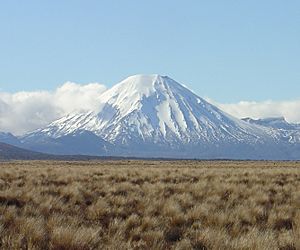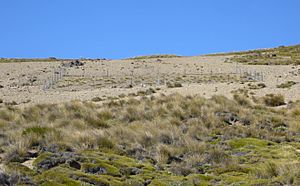Tussock grasslands of New Zealand facts for kids
Tussock grasslands are special landscapes found mostly in the South Island of New Zealand. You can also find some in the central part of the North Island. These grasslands are named after the main plants that grow there: tussocks.
Tussocks are a type of grass that grows in clumps. They look like big bunches of grass. Most of the plants called tussocks belong to plant groups like Carex, Chionochloa, Festuca, and Poa.

Contents
What Are Tussock Grasslands?
In other parts of the world, similar areas might be called "herbfields" or "bunchgrass meadows." But in New Zealand, they are known as tussock herbfields. This is because tussock plants are the most common type of plant found there.
Snow Grass: The Giants of the Tussocks
The largest tussock plants are often called snow grass or snow tussocks. These impressive plants can grow very tall, sometimes reaching up to 2 metres (about 6.5 feet) in height!
Snow grass grows very slowly. Some of these plants are incredibly old, possibly hundreds of years old. This means they have been growing in the same spot for a very long time.
Why Are Tussocks Important?
Tussock grasslands are important habitats for many native New Zealand animals. They provide food and shelter for insects, birds, and lizards. These areas also help to prevent soil from washing away, especially on hillsides.
Protecting Tussock Grasslands
Sometimes, animals that were brought to New Zealand, like deer or goats, eat a lot of the tussock plants. This can make it hard for new tussocks to grow. To help protect these plants, scientists sometimes set up fenced areas. These fences keep animals out, allowing the tussocks inside to grow tall and healthy. This helps scientists learn how to best protect these unique grasslands.


